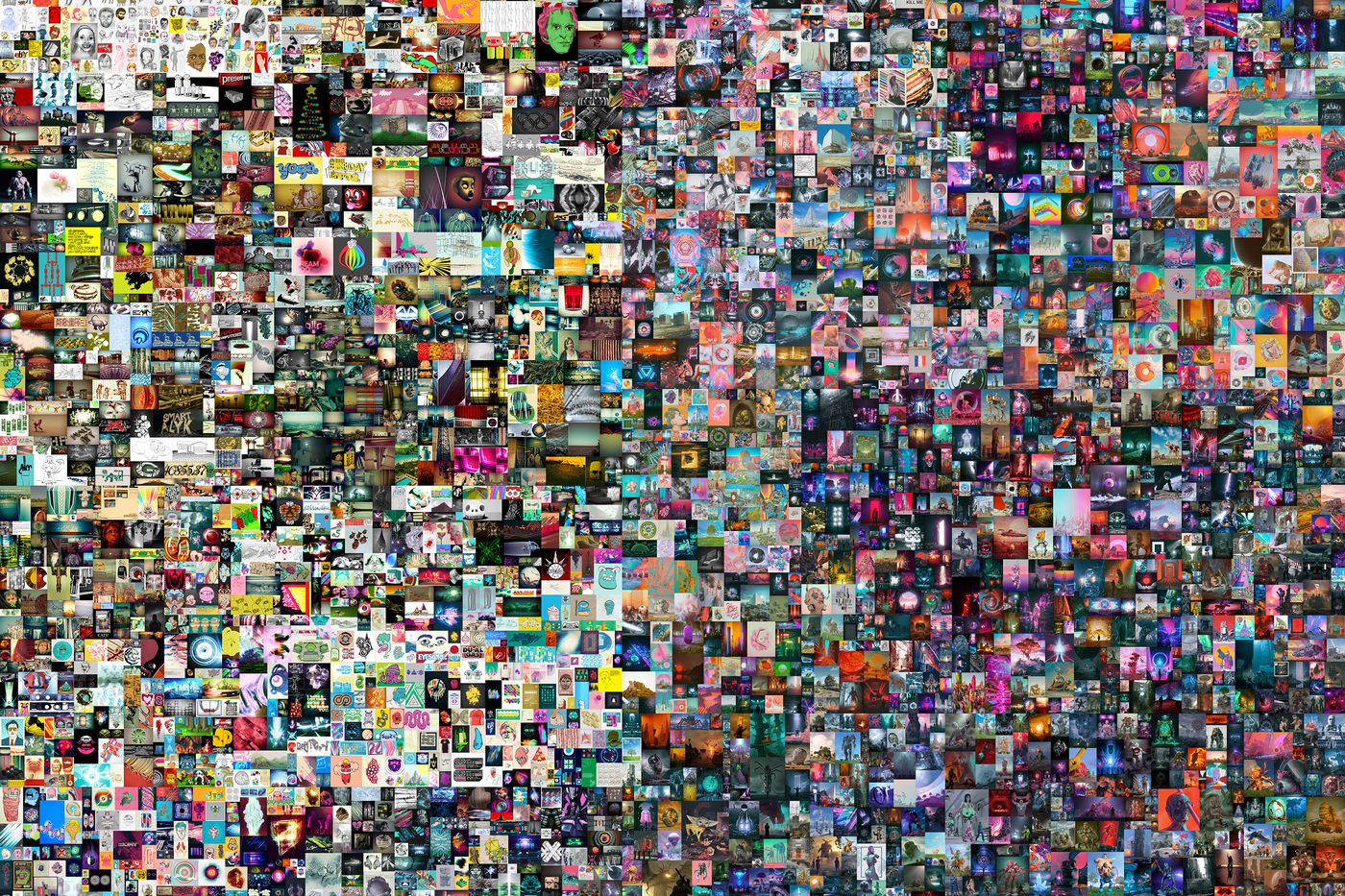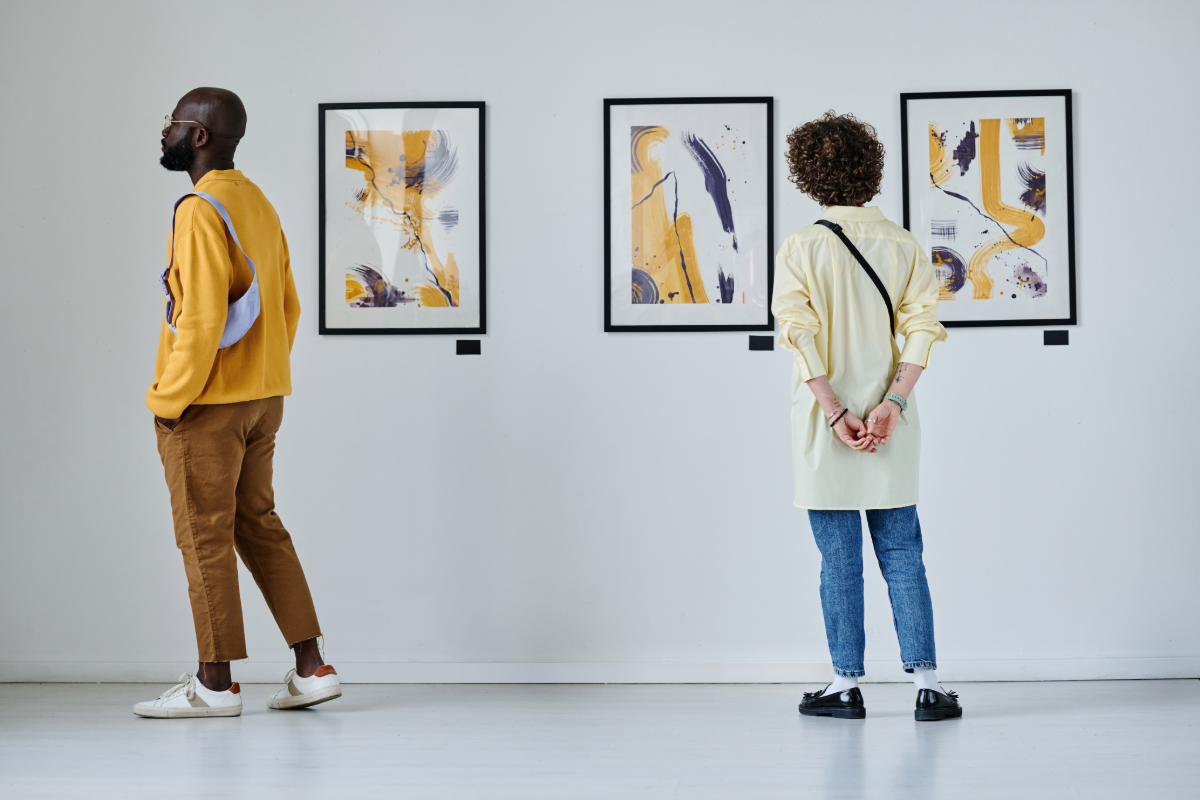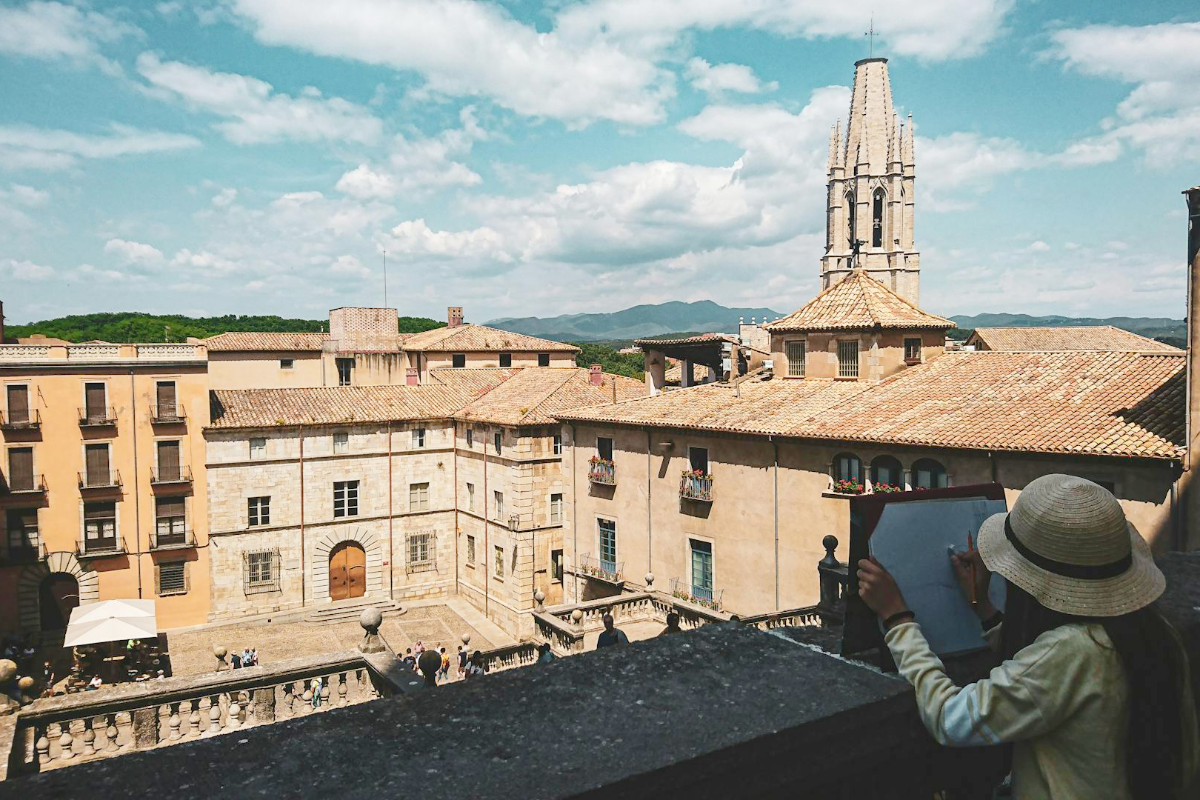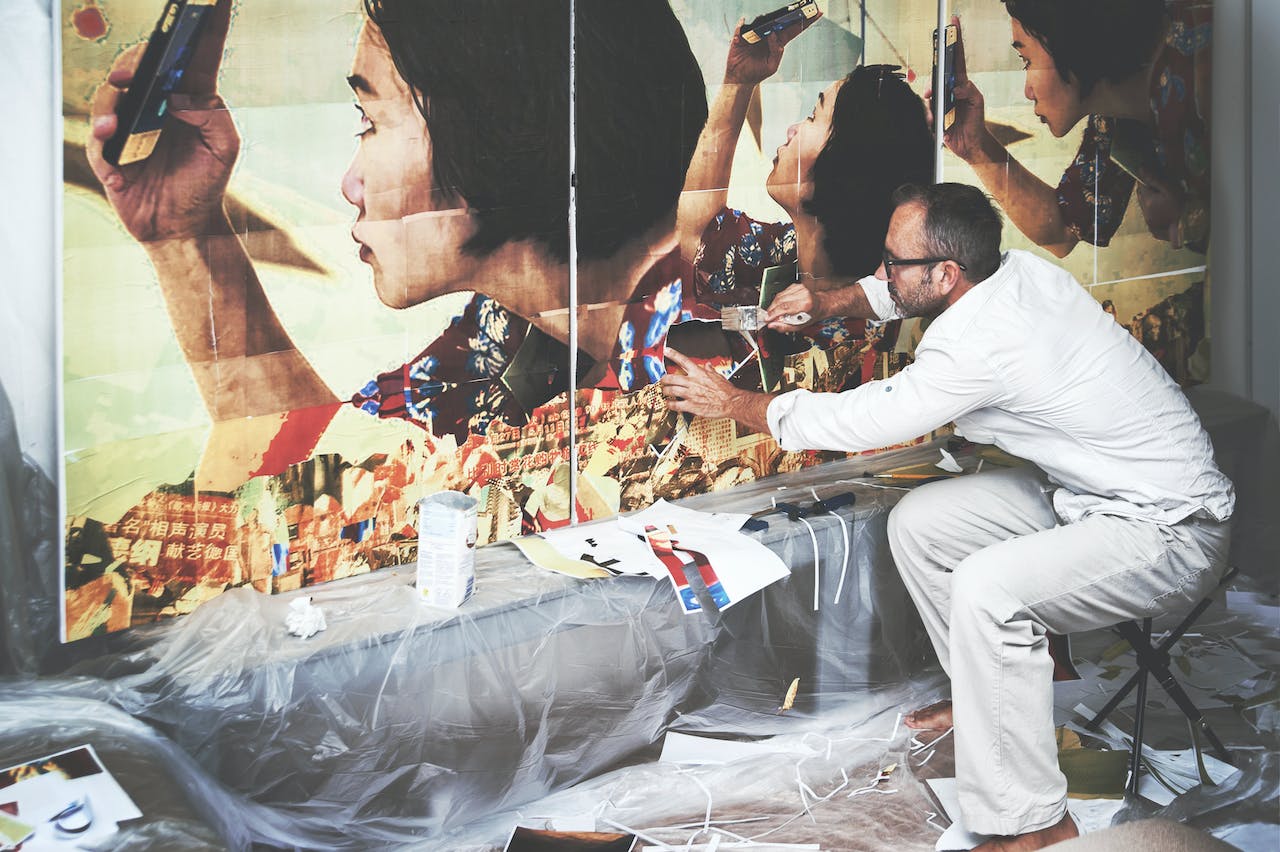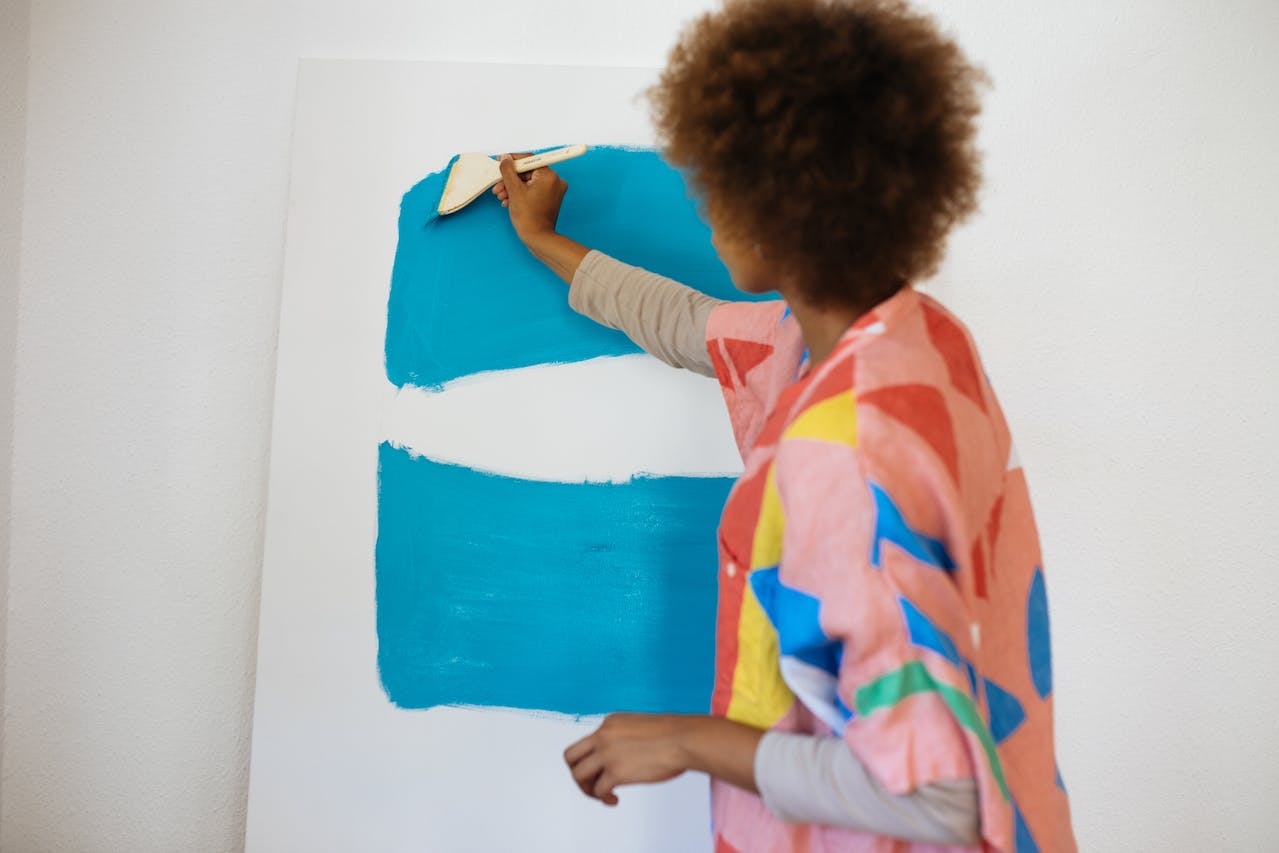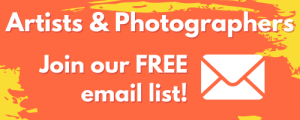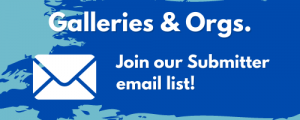What Are NFTs, & What Do They Mean for the Art World?
Over the last year, NFTs have dramatically changed the art world. If you’ve only recently heard about NFTs, you’re not alone! The technology is relatively new and ever-evolving in what some have likened to a digital gold rush. In many ways, NFTs, or Non-fungible tokens, hold similar qualities to items in the “real” world; NFTs can be anything digital, from drawings and paintings to music, memes, GIFs, and more. But a lot of the current excitement around NFTs is that they could be the future of fine art collecting, only with digital artwork. On March 11, 2021, Christie’s made history when it sold American digital artist Beeple’s work Everydays: The First 5000 Days for a mind-blowing $69.3 million at auction. Yes, you read that right; sixty-nine million three hundred thousand dollars for a purely digital image. The renowned 255-year-old auction house made further NFT history when it offered physical paintings accompanied by tokens from the female-led digital arts collective, Rewind Collective.
NFT technology was invented as a way for digital creators and artists to assert the originality of their work, in a medium where replicates are easily produced. However, NFTs have also opened up new revenue streams for museums. Earlier this year, the Uffizi Gallery in Florence began turning some of its most prized artworks into NFTs and selling them to raise funds after a cash-strapped year fueled by the pandemic. It started with a bang, selling an encrypted Michelangelo painting of the holy family, Doni Tondo (1505–06), for more than $170,000.
Ultimately, NFT artwork is intended to benefit artists and art collectors. The process allows digital artists to gain formal recognition for their work, similar to how a painter is credited for their work. But what exactly are NFTs, and what opportunities does the technology provide for artists? We’ve got you covered in this guide.
What is an NFT?
A Non-fungible token, or NFT for short, acts as a one-of-a-kind trading card of sorts. Non-fungible means that it’s unique and cannot be replaced with something else. Currency, like Bitcoin, on the other hand, is fungible. If you traded one bitcoin for another, you’d still have precisely the same thing. A one-of-a-kind trading card, however, is non-fungible. Swap it for a different card, and you’d have something else entirely.
NFTs are unique and distinguishable from one another by a serial number, or token ID, which is stored on the blockchain (more on that in a moment). The token ID works in the same way as a barcode; the code corresponds to the information about that particular item: how it looks, the artist or organization that made it, its distinguishing attributes, and more.
Most NFTs are a part of the Ethereum blockchain. Ethereum is the technology powering the digital currency (also known as cryptocurrency) ether (ETH), which is similar to Bitcoin (BTC) or Dogecoin (DOGE). However, Ethereum’s blockchain also supports NFTs, which store extra information prudent to the accompanying art piece, making them work differently from crypto coins. When a digital file has an NFT attached, the digital file can be replicated, but the Blockchain-certified token cannot. The original digital file can now be bought and sold – and more importantly – collected like fine art.
To put it in terms of physical art collecting: Anyone can buy a Rothko print – but only one person can own the original. So let’s say, for instance, you purchased a Rothko painting at an auction. You knew exactly what you were getting – a masterpiece, yes – but in the simplest terms, you bought a large canvas with some paint on it. What makes this particular piece special is that the person who put the paint on the canvas was, well, Rothko. And of course, the fact that there is only one canvas in existence with paint on it in that particular way is what makes the piece rare; only one person can own the original version of it – which is the same case for an NFT. However, NFT buyers do not usually acquire copyrights or reproduction rights of whatever it is they purchase. Most of the time, they’re buying bragging rights and the knowledge that their copy is the “authentic” one.
People have long attached emotional and aesthetic value to physical goods like fine art or antiques and have been willing to pay a lot of money for them. But until recently, digital media didn’t hold the same value because it could be easily copied, shared, and stolen. Blockchain technology (which is most often associated with Bitcoin) is changing that. Let’s take a look at what exactly the blockchain is.
What is the Blockchain?
A blockchain is a digital record of transactions; it is a list in its simplest form. When someone buys or sells digital content such as artwork, GIFs, music, or videos, the transaction is recorded on a digital list. Another person buys or sells a piece of digital content? An additional record is made. And so on. These digital records are called “blocks,” and they are chained together to create a massive list. Each record needs to be verified by multiple computers, which helps to ensure that one system cannot invalidate the chain or make false records. This is how cryptocurrencies like Bitcoin work. When it became possible to create a digital record of ownership for money using the blockchain, people began asking why it couldn’t be done for all sorts of other things, too. And that’s exactly what people are now doing with art.
With the blockchain, it’s possible to track the ownership of digital wares, including artwork. The person who owns it can resell it, license the rights to a museum to display it, or even control the conditions under which it is displayed.
How Can Artists Make Money with NFTs?
So, now that you’ve got the basics down – how do you take a digital piece of artwork that you’ve created and add a token to it that someone else can buy? There are numerous websites and NFT marketplaces that allow you to upload your artwork, add it to the blockchain, and then sell it. Keep in mind, when it comes to NFT marketplaces, there is no one-size-fits-all. Perhaps there’s a marketplace with an approach you appreciate, or you’re an artist who works with an underrepresented medium with a thriving community on a specific platform.
Remember, there’s no reason to pick just one NFT marketplace; mix and match, experiment, and see which platform works best for you and your artwork.
Let’s explore five of the top NFT marketplaces for artists:
1. OpenSea
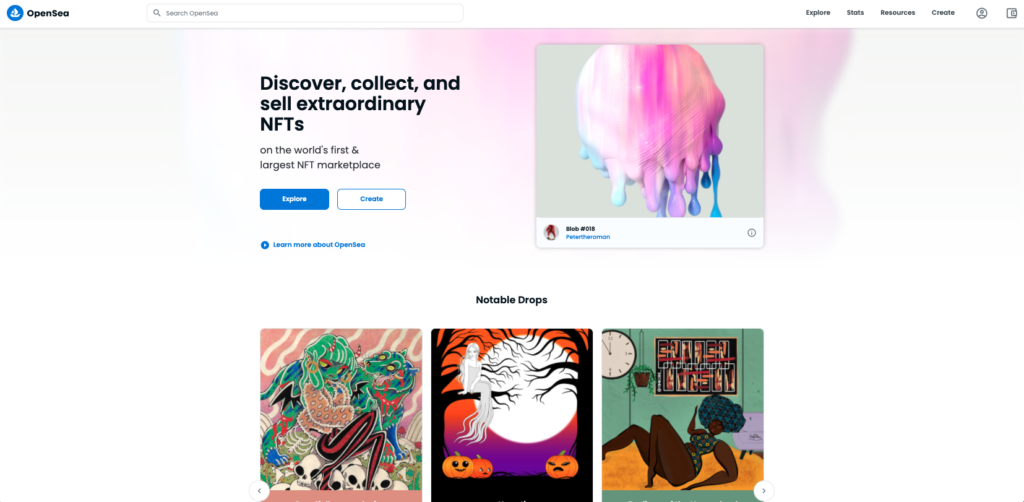
OpenSea is the original peer-to-peer NFT marketplace and by far the largest, offering NFTs of everything from artwork to music, memes, GIFs, avatars, in-game items and collectibles, and more. At the time of writing, OpenSea has over 200,000 active monthly traders, with a total trading volume of over $9.9 billion (according to the analytics platform DappRadar).
In addition to the variety of NFT opportunities they offer to artists and collectors, OpenSea also has a quick way to view the activity for each collection listed on their platform which aggregates all the data from the collection and quickly provides a variety of information like floor price, highest last sale, and the total overall trading volume for a collection.
Signing up is as easy as connecting your Coinbase wallet or another supported wallet. Once you’re connected, uploading your NFT creation is a straightforward process. Simply head to the “Create” tab, connect your wallet (as a creator), upload your file and mint it, fill out the description, and wait for the money to roll in.
Blockchain(s): Ethereum, Polygon, Tezos (coming soon)
Supported currencies: ETH, WETH, DAI, USDC, MEME
Token support: ERC-1155, ERC-721
Type of sales: Auctions, fixed price, open offers Fees: Lazy minting (low transaction cost) + 2.5% marketplace fee
2. Rarible
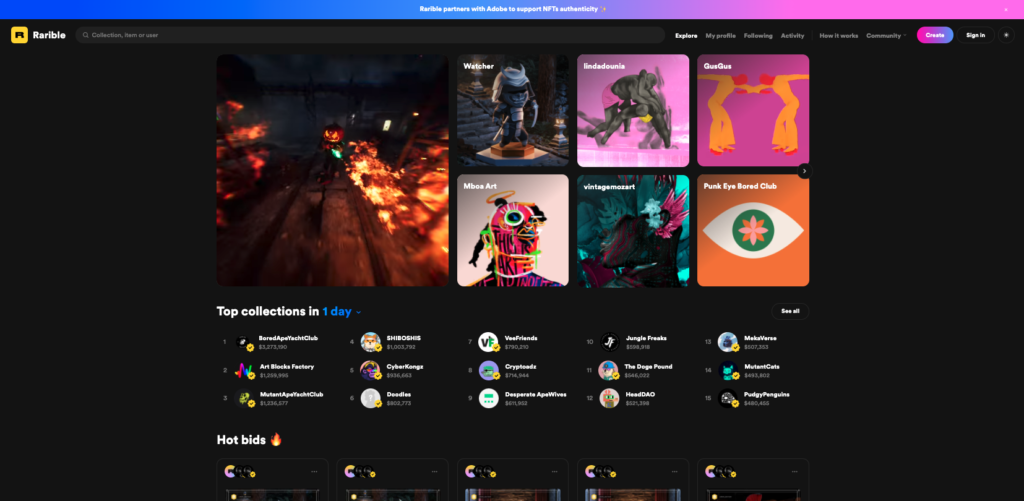
One of the leading NFT marketplaces on Ethereum, Rarible currently has the sixth-highest all-time trading volume according to DappRadar, with nearly $260 million in transactions. Rarible is an NFT community-owned platform that showcases various digital wares, including art and collectibles. Rarible’s user interface is simple enough for crypto beginners to use. Sellers also have the option to create more than one NFT for a single image, selling it more than once.
You can log into Rarible using various crypto wallets, including Coinbase Wallet, MetaMask, or any other mobile wallet using WalletConnect. Once you’ve signed in, you can use funds in your wallet to buy NFTs, or even top up your wallet with fiat currency via debit card or bank transfer. Rarible provides verified badges to authentic and dedicated collectors and creators. Users have to fill a form to get verified. Additionally, you can view and manage your Rarible collectibles on OpenSea.
Blockchain(s): Ethereum
Supported currencies: ETH, WETH, DAI, RARI, ATRI
Token support: ERC-1155, ERC-72
Type of sales: Auctions, fixed priceFees: Gas fees (transaction fees, lazy minting coming soon) + 2.5% marketplace fee
3. SuperRare
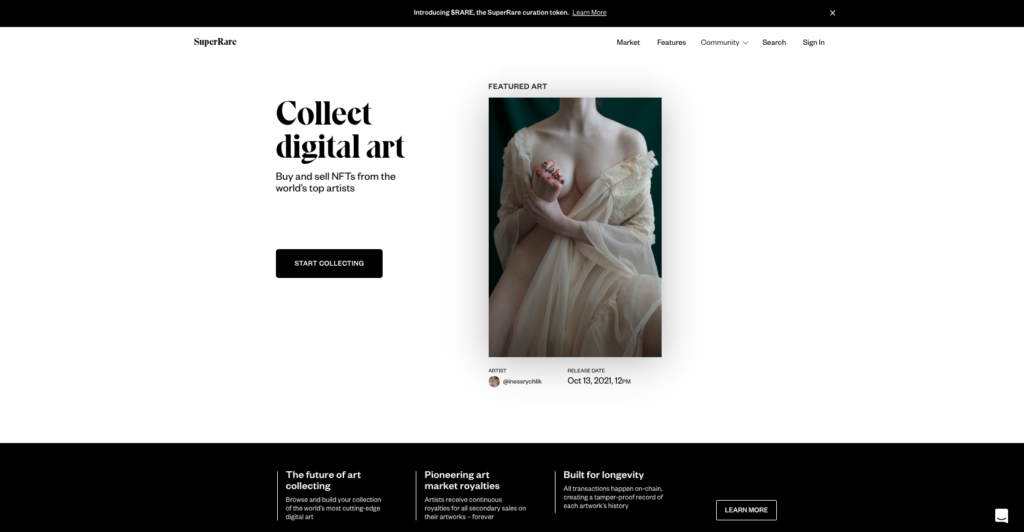
Think of SuperRare as an exclusive, high-end alternative to other NFT marketplaces like Rarible. One of the top NFT marketplaces for fine art, SuperRare is more heavily curated, aiming to provide a gallery-like experience for the discerning NFT connoisseur and billing itself as a social platform (“You can think of SuperRare like Instagram meets Christie’s.”) that encourages the creation and collection of crypto art. SuperRare works closely with artists, requiring artwork to be submitted and approved before it is listed. Perhaps the biggest perk of selling on this platform? Artists selling their works on SuperRare receive continuous royalties for all secondary sales on their artworks, forever.
SuperRare is currently still in early access, onboarding only a small number of hand-selected artists. You can use this form to submit your artist profile and get on SuperRare’s radar for their full-launch next year.
Sign up to collect on SuperRare by creating an account and connecting it with an Ethereum wallet.
Blockchain(s): Ethereum
Supported currencies: ETH
Token support: ERC-721
Type of sales: Auctions, fixed price
Fees: 3% minting fee + 15% marketplace fee
4. KnownOrigin
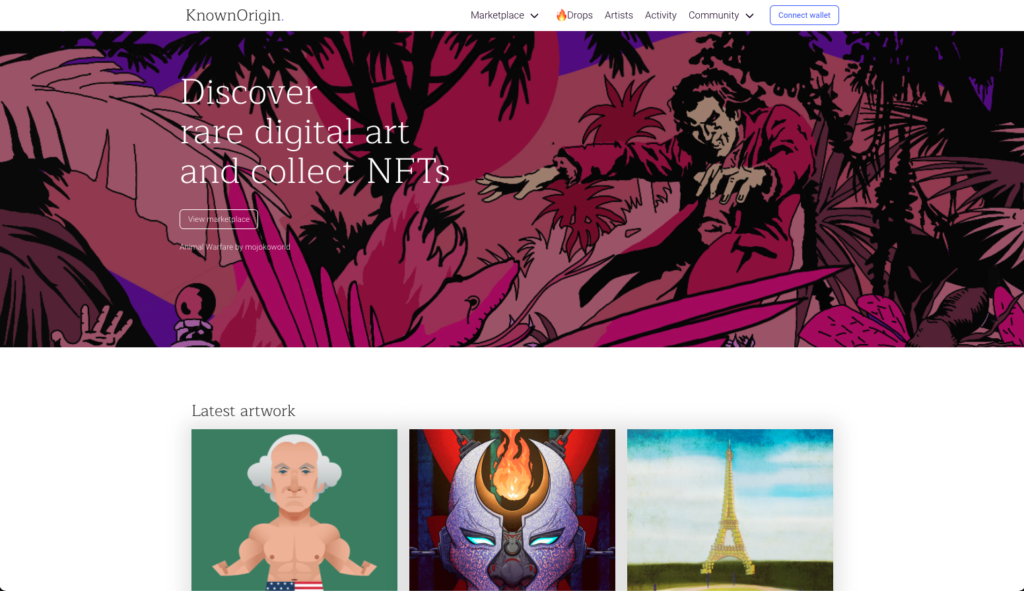
Similar to SuperRare, KnownOrigin aims to provide a high-end gallery-like experience for NFT collectors, with a strong focus on digital artwork rather than wares like GIFs and wacky avatars. All of KnownOrigin’s artwork files are held on IPFS, or InterPlanetary File System. In brief, rather than identifying a specific file at a particular domain, IPFS addresses let you find a piece of content so long as someone somewhere on the IPFS network is hosting it. This provides a measure of protection for the underlying assets. Grimes’ NFT uses this as a backup, and Beeple’s NFT primarily uses it as well.
KnownOrigin is simple to use; connect your crypto wallet and start collecting in no time.
Blockchain(s): Ethereum
Supported currencies: ETH
Token support: ERC-721
Type of sales: Auctions, fixed priceFees: Gas fees (transaction fees) + 15% marketplace fee
5. Foundation
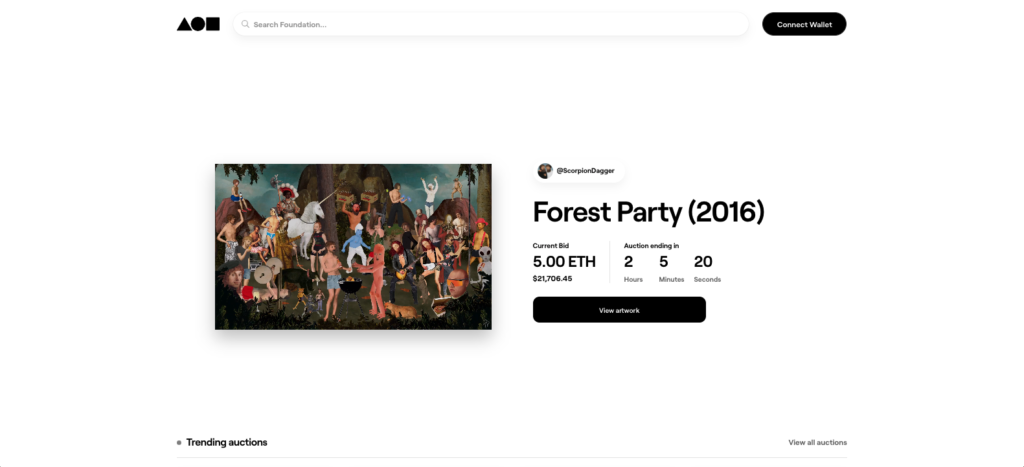
Foundation is another exclusive boutique NFT marketplace, billing itself as a “creative playground” for artists. It has hosted several notable sales, including the NFT of the iconic Internet meme “Nyan Cat,” which sold for roughly $580,000, and Edward Snowden’s first NFT, entitled “Stay Free,” which sold for more than $5.4 million.
To sell on Foundation, artists must be invited by the community. If you’re an artist looking to join the Foundation marketplace and have a large Twitter following, rally your followers to help you get an invite! After entering the marketplace, artists can then mint and sell their NFTs.
Meanwhile, collectors can search through Foundation’s featured artwork and place bids on available artworks. When a collector places a bid and meets the artist’s reserve price, a 24-hour auction begins, often resulting in some exciting bidding wars between collectors.
Blockchain(s): Ethereum
Supported currencies: ETH
Token support: ERC-721, proprietary
Type of sales: AuctionsFees: Gas fees (transaction fees) + 15% marketplace fee
Final Thoughts
To summarize, NFTs are like “proof of ownership” certificates etched into the blockchain; they allow collectors to own digital assets, including artwork, photographs, memes, GIFS, videos, and more, creating a new revenue stream for artists and digital creators. That said, NFTs still have plenty of room to grow. They currently have an extremely high carbon footprint – and while each NFT is unique, there have still been cases of art theft, forgeries, and even artists’ identity theft.
Many are hopeful that this emerging technology will soon shift to truly benefit the artists and designers it was intended for in the first place. The selling of NFT artwork holds the potential to transform the creative industry, forever. Its emergence is only the beginning of something that may perhaps feel mundane to future generations. At TheArtList, we are excited to be a part of this historical shift in the art world and can’t wait to find our place within it.
At TheArtList, we’re passionate about helping artists thrive in their careers. In our ongoing Art Marketing 101 series, we’ll walk you through step-by-step how to make the best online portfolio to showcase your artwork and market your work and personal brand. Subscribe to our Artist & Photographer Mailing List so you won’t miss any upcoming blog posts. You’ll also receive our monthly newsletter showcasing our Artist of the Month contest winners and art calls delivered directly to your inbox!
And if you’re an art gallery, museum, or organization looking to promote your art calls, contests, exhibitions, or events, subscribe to our Submitter Mailing List. You’ll receive our monthly newsletter showcasing some remarkable up-and-coming talent, as well as the occasional discount on our promotional packages!

